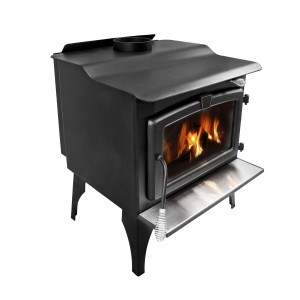After acquiring a wood burning stove, you need to ensure that you are getting the most from it. This will only happen if you know how to operate a wood burning stove like a pro. Past experience is not needed for you to operate a stove. All that is required of you is learning a few tips that will make it easy for you to light and operate the stove.
Lighting A Wood Burning Stove
There is no standard way to light a wood stove. Different people use different methods to light a stove. Lighting a wood burning stove takes the same route as lighting a conventional stove/fireplace. If you are aiming for a hot firebox with no smoke, you need to know what to go for and what to avoid. Contrary to what many people tend to think, it is not the well seasoned wood or a good chimney that make it easy to light the stove–instead, it depends on the technique.
For a fire to ignite, the wood needs some heat. You therefore need to ensure that you are accumulating the little heat produced from the very beginning. Most stoves are designed to cater to this purpose and have a insulating lining to ensure that the heat is accumulated inside the stove. The lining may not be enough, though, and you will need to incorporate other techniques. One of such techniques is the use of ash. Many people only view the ash as waste, but it plays a very significant role in the lighting process. The layer of ash at the bottom of the firebox acts as an insulating layer that directs the heat upwards. Therefore, you should never empty all the ash when cleaning the stove.
Some stoves also come with a grate. This grate comes in handy when igniting the fire. With the presence of the grate, you do not need to have some ash in the stove. All that you need to do is ensure that the grate holes are open. These holes will allow air to flow into the stove. The rushing air brings in oxygen, which is vital in the lighting process. The air can also come in through the air control, located at the top of the stove, or the tertiary flowing through the back of the stove.
The next step would be the actual ignition. This is done best using some newspapers. Scrunch them up loosely to ensure that they don’t burn too quickly. You can also use pieces of cardboard. On top of the newspapers or cardboard, place finely chopped wood (10-20mm); preferably softwood. Small softwood twigs are excellent kindling pieces. Arrange them nicely to avoid flattening the paper. You can add one larger log on top of the heap. Light the newspaper and close the door. The fire will spread to the wood and burn freely within five minutes.
Operating The Wood Stove
After five minutes, more logs will need to be added to the fire. This ensures that the fire doesn’t smother out. Let the logs catch fire before changing the airflow into the stove. This should take around 10 to 15 minutes. After this, you can then turn the air controls to regulate the amount of air entering the stove. Wood burning generally prefers air flowing from above. This means that you should first turn down the bottom air controller. The amount of air allowed will be dictated by the fire. If you realize that the fire seems to be dying or producing a lot of smoke after turning down the air controller, you have gone too far and should open the air controllers to allow some air in. After 30 to 40 minutes, the stove should be running smoothly. At this time, it will have achieved temperatures high enough to heat the room. A nice mesmerizing rolling effect will also be seen through the glass door.
What Is The Right Time To Refuel The Stove?

Wood burning stoves are known to last between eight and 14 hours on a single fueling. This means that they can burn overnight without the need to refuel. The interval between refueling sessions is mainly determined by the quality of wood. With hardwoods, you can expect the stove to last longer than when using softwoods. You will know it is time to refuel after looking at the stove and not the stopwatch. The fuel load you expected to last 10 hours may only last eight hours. After this, you will realize that the logs will have burnt to embers. This is the time to refuel. Do not wait until all the visible flames have disappeared. Add a couple of logs and open air controls to let in some air.
You will need to open the stove’s door when refueling. This should be done slowly to allow the fire and chimney to get used to the high air flow. The flue damper should also be opened before opening the door. This will avoid having a puff of smoke spreading into the room. If you do not want to refuel the stove, you can turn down the air controls, but not completely. This way, you will control the rate at which the remaining heat is distributed, and be able to enjoy the heat a bit longer of them Die Eurojackpot-Zahlen heute, 18. Mai 2018 – dofaq.com.
What To Avoid When Operating A Wood Burning Stove

- Avoid using ethanol, paraffin, petrol or similar products when lighting the stove
- When lighting the stove, do not leave it unattended. This can result in fire hazards
- Avoid burning coal in a wood burning stove. Burning coal gives out sulfuric acid which sticks on the chimney. If combined with moisture, the sulfuric acid will corrode your chimney and even the stove. The stove’s lifespan will be reduced significantly













